Joe Blevins's Blog, page 19
August 3, 2024
So... whatever happened to serial killers?
 Are serial killers a thing of the past?
Are serial killers a thing of the past?Remember serial killers? Those sweaty, shifty-eyed men who used to dominate the news cycle? Sure, you do. They used to be the stuff of nightmares. They were all over TV. Remember TV? Serial killers were huge on there. Movies, too. And books, magazines, and newspapers. You youngsters may not remember, but us older folks will never forget.
For a few decades, serial killers dominated popular culture. We needed something to fill the void after The Beatles broke up, and apparently they were it. You'd see them being taken away in handcuffs after the police discovered their crawlspace full of human torsos. Later, they'd spout some wackadoo gibberish while defending themselves in court. Sometimes, they'd have three names, like John Wayne Gacy or Henry Lee Lucas.
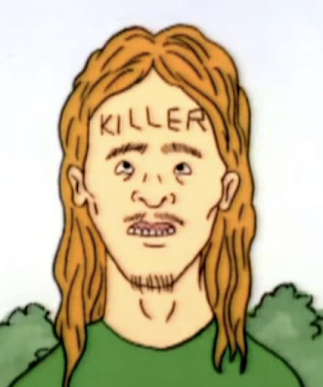 Enjoy the '90s while they last, pal.We'd be horrified by their crimes, but we'd be compelled, too. They became antiheroes. People wrote them fan letters. In the '90s, you'd occasionally see their intense faces staring at you from magazine covers and T-shirts. Your "edgy" friend might name his terrible band after one of them. There were tasteless jokes and SNL sketches about them.
Enjoy the '90s while they last, pal.We'd be horrified by their crimes, but we'd be compelled, too. They became antiheroes. People wrote them fan letters. In the '90s, you'd occasionally see their intense faces staring at you from magazine covers and T-shirts. Your "edgy" friend might name his terrible band after one of them. There were tasteless jokes and SNL sketches about them.So what happened to those guys? From roughly the 1970s to the '90s, you could count on a new serial killer every few years. They were an important part of the news cycle. We depended on them, if only for reassurance that we ourselves weren't so bad. "At least I'm not that guy," you could think.
And then... what? We just collectively stopped serial killing? You're asking me to believe that serial killing was just some kooky phase we went through as a society and got over? People got bored with it? Moved on to something else? I can't even remember the last new serial killer to become a media sensation. It's been decades. Where are the Bundys and Dahmers of tomorrow coming from? I ask you.
I refuse to believe that the human race has evolved beyond serial killing. We're not one bit better than we were in the '80s and '90s. If anything, we're worse. Like, a lot worse. We're more violent, delusional, and narcissistic than we ever were. I guess, in the 21st century, we've shifted from serial killing to mass murder. Which, like, sure. It's more efficient. I get it. You can kill a bunch of people at one time and become just as notorious, feared, and hated.
But there was a certain artistry, if you want to call it that, to serial killing. If you, as a killer, spread your crimes out over a period of months or even years, you could create compelling narrative that wouldn't be possible with just a single afternoon of bloodshed. You could develop a mystique. Hollywood understood this. Think of Norman Bates, Michael Myers, Hannibal Lecter—serial killers all, not a mass murderer in the bunch.
You know who I think ruined it? The BTK guy. First off, his nickname makes you think of Burger King. Secondly, when they finally found him, he looked like an assistant manager at Denny's. Hardly the kind of guy to wind up on a T-shirt. A lot of the mystique was gone. And then, after Oklahoma City, Columbine, and 9/11, serial killers were yesterday's news. They seemed quaint. In recent decades, sex-related crimes have arguably eclipsed murder in the public imagination.
It's obvious that we're still fascinated with serial killers in the 21st Century. There are plenty of movies and TV shows about them being made, but the killers themselves are either fictional or decades-old. Bundy's used up. Gacy's used up. Dahmer is beyond used up. Maybe the age of serial killers is gone forever. It's not that I want them to come back, exactly. But it is strange that they vanished from the scene, isn't it?
var infolinks_pid = 3415273; var infolinks_wsid = 0;
Published on August 03, 2024 16:05
July 31, 2024
Ed Wood Wednesdays, week 198: The difficulty of finding things when you don't know what you're looking for
 Conrad Brooks (left) and Paul Marco in Plan 9 from Outer Space.
Conrad Brooks (left) and Paul Marco in Plan 9 from Outer Space."It's tough to find something when you don't know what you're looking for."
Conrad Brooks says that notorious line about 37 minutes into Ed Wood's Plan 9 from Outer Space (1957), approximately the halfway point in the movie, and his fateful words have been evoking laughs from audiences for decades. The line has become iconic in its own way, so much so that an older Conrad Brooks playfully quotes himself in the documentary Flying Saucers Over Hollywood (1992).
A strange thought occurred to me recently, though: why?
What, exactly, is it about the line that makes it funny? Certainly, Brooks is speaking the truth here; it really is tough to find something when you don't know what you're looking for. Imagine being sent on a scavenger hunt without a list of specific items to locate. You'd have a tough time of it, right? So the character's logic is airtight. Nevertheless, the line hits our ears as unmistakably stupid, the kind of thing only a person with no self-awareness would say.
Partly, the humor comes from Conrad Brooks' utterly earnest, sincere delivery. He acts as though he has said something of importance when he has really communicated nothing. But consider his circumstances. His character in Plan 9, Jamie, is a uniformed Los Angeles cop who has been dispatched to a spooky, fog-shrouded cemetery that has been the site of several recent murders and other strange, supernatural incidents possibly involving zombies, aliens, and UFOs. Just what's been happening in this place, nobody knows.
It's a case so baffling it would test the mettle of even a seasoned lawman. Certainly, such matters are beyond Jamie's ken. Jamie's own boss, the venerable Inspector Daniel Clay (Tor Johnson), has recently been killed at this very cemetery. Now, a local woman named Paula Trent (Mona McKinnon) has reported being chased through the cemetery by a ghoulish old man (Bela Lugosi/Tom Mason). Jamie has been ordered to search the grounds, but what is he looking for? How will he even know when he finds it?
To make matters worse, Jamie has been paired with the least valuable man in the department, the bumbling Officer Kelton (Paul Marco). It is to Kelton that Jamie makes his infamous remark. The two officers do not seem to get along well—no one on the force likes Kelton—and Jamie is especially irritable because his shift ended an hour ago. How is a man supposed to make great insights under such conditions?
var infolinks_pid = 3415273; var infolinks_wsid = 0;
Published on July 31, 2024 03:00
July 24, 2024
Ed Wood Wednesdays, week 197: Comparing multiple prints of 'Glen or Glenda' (1953)
 Here we see a side-by-side comparison of two prints of Glen or Glenda.
Here we see a side-by-side comparison of two prints of Glen or Glenda.If movies are made in the editing room, then Ed Wood's debut feature, Glen or Glenda (1953), was made, unmade, and remade several times over. I can't keep track of how many different versions of this film there are, and each one is as unique as a fingerprint. (Notice how fingerprints look pretty much the same from a distance but reveal their differences under scrutiny.) Over the decades, this movie has been released under innumerable titles, including I Led 2 Lives, Transvestite, and He or She. In the Ed Wood canon, perhaps only Orgy of the Dead (1965) has more aliases. The content of the film has also changed noticeably from one edition to another, with certain lines or even whole scenes being added or omitted.
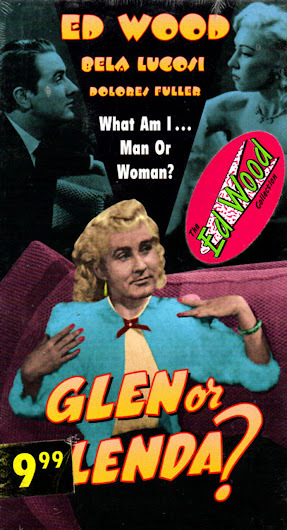 Still my favorite edition of Glenda.This phenomenon is as old as the film itself. Producer George Weiss infamously added saucy burlesque footage to an extended dream sequence late in the film, apparently without consulting Ed Wood. He did this for a number of reasons: to pad the run time, to add some sex appeal, and to reuse footage that he already owned. As a result, I don't think that there is any such thing as a "definitive" or "complete" cut of Glen or Glenda. As much as I'd like to see Criterion release a director's cut of this significant (and still shockingly relevant) motion picture, I don't think such a thing is possible.
Still my favorite edition of Glenda.This phenomenon is as old as the film itself. Producer George Weiss infamously added saucy burlesque footage to an extended dream sequence late in the film, apparently without consulting Ed Wood. He did this for a number of reasons: to pad the run time, to add some sex appeal, and to reuse footage that he already owned. As a result, I don't think that there is any such thing as a "definitive" or "complete" cut of Glen or Glenda. As much as I'd like to see Criterion release a director's cut of this significant (and still shockingly relevant) motion picture, I don't think such a thing is possible.The first version of the film that I ever saw was the one released by Rhino Video in 1996 as part of its Ed Wood Collection series of VHS tapes. This was the edition that I meticulously transcribed decades ago, and as far as I know, it's the lengthiest cut of Glen or Glenda that you can buy. Even here, though, are what some may consider impurities. Rhino's edition contains the Weiss-added burlesque footage, for instance, which irks certain Ed Wood fans. And the title card was obviously doctored—and crudely at that—by distributor Wade Williams. (My guess is that Williams' print carried one of the film's lesser-known alternate titles.) Nevertheless, Rhino's Glen or Glenda remains my preferred edition of the film.
I was rather dismayed that, starting in the 2000s, the most commonly-available Glen or Glenda DVD on the market (included in popular sets like The Worst of Ed Wood and The Ed Wood Box ) was from Image Entertainment and mastered from a censored, shortened print of the movie that lacked several key moments! When Legend Entertainment released its colorized version of Glen or Glenda in 2012, they used this censored cut of the movie. Even Rob Craig's exhaustive book Ed Wood, Mad Genius (2009) used the bowdlerized Image Entertainment version of Glen or Glenda for reference.
How do you know if the version of Glenda you're watching is the censored version? There's an easy test. Fast forward to the first conversation between Inspector Warren (Lyle Talbot) and Dr. Alton (Timothy Farrell) until you get to this bit of dialogue:
If Dr. Alton's "I don't think so" is missing, you have the censored Glen or Glenda. Again, I humbly refer you to my transcript of the entire movie. I've highlighted all the missing and excised material in red.
DR. ALTON: Most of us have our idiosyncrasies.
INSPECTOR: This fellow's was quite pronounced.
DR. ALTON: Yes, but I wonder if it rated the death warrant it received. I don't think so.
INSPECTOR: Well, that's why I'm here today, Doctor. What do we do about it?
You may also remember that, back in 2020, there was some hubbub about a restored 35mm print of Glen or Glenda that received some theatrical showings and was briefly available as a digital download from the American Genre Film Archive (AGFA). Any fans hoping for a "definitive" or "complete" edition of Glenda quickly had their hopes dashed when they saw the results. As Greg Dziawer pointed out in his article, this was the shortest edition yet of the film, even shorter than the Image DVD!
var infolinks_pid = 3415273; var infolinks_wsid = 0;
Published on July 24, 2024 03:00
Ed Wood Wednesdays: Comparing multiple prints of 'Glen or Glenda' (1953)
 Here we see a side-by-side comparison of two prints of Glen or Glenda.
Here we see a side-by-side comparison of two prints of Glen or Glenda.If movies are made in the editing room, then Ed Wood's debut feature, Glen or Glenda (1953), was made, unmade, and remade several times over. I can't keep track of how many different versions of this film there are, and each one is as unique as a fingerprint. (Notice how fingerprints look pretty much the same from a distance but reveal their differences under scrutiny.) Over the decades, this movie has been released under innumerable titles, including I Led 2 Lives, Transvestite, and He or She. In the Ed Wood canon, perhaps only Orgy of the Dead (1965) has more aliases. The content of the film has also changed noticeably from one edition to another, with certain lines or even whole scenes being added or omitted.
 Still my favorite edition of Glenda.This phenomenon is as old as the film itself. Producer George Weiss infamously added saucy burlesque footage to an extended dream sequence late in the film, apparently without consulting Ed Wood. He did this for a number of reasons: to pad the run time, to add some sex appeal, and to reuse footage that he already owned. As a result, I don't think that there is any such thing as a "definitive" or "complete" cut of Glen or Glenda. As much as I'd like to see Criterion release a director's cut of this significant (and still shockingly relevant) motion picture, I don't think such a thing is possible.
Still my favorite edition of Glenda.This phenomenon is as old as the film itself. Producer George Weiss infamously added saucy burlesque footage to an extended dream sequence late in the film, apparently without consulting Ed Wood. He did this for a number of reasons: to pad the run time, to add some sex appeal, and to reuse footage that he already owned. As a result, I don't think that there is any such thing as a "definitive" or "complete" cut of Glen or Glenda. As much as I'd like to see Criterion release a director's cut of this significant (and still shockingly relevant) motion picture, I don't think such a thing is possible.The first version of the film that I ever saw was the one released by Rhino Video in 1996 as part of its Ed Wood Collection series of VHS tapes. This was the edition that I meticulously transcribed decades ago, and as far as I know, it's the lengthiest cut of Glen or Glenda that you can buy. Even here, though, are what some may consider impurities. Rhino's edition contains the Weiss-added burlesque footage, for instance, which irks certain Ed Wood fans. And the title card was obviously doctored—and crudely at that—by distributor Wade Williams. (My guess is that Williams' print carried one of the film's lesser-known alternate titles.) Nevertheless, Rhino's Glen or Glenda remains my preferred edition of the film.
I was rather dismayed that, starting in the 2000s, the most commonly-available Glen or Glenda DVD on the market (included in popular sets like The Worst of Ed Wood and The Ed Wood Box ) was from Image Entertainment and mastered from a censored, shortened print of the movie that lacked several key moments! When Legend Entertainment released its colorized version of Glen or Glenda in 2012, they used this censored cut of the movie. Even Rob Craig's exhaustive book Ed Wood, Mad Genius (2009) used the bowdlerized Image Entertainment version of Glen or Glenda for reference.
How do you know if the version of Glenda you're watching is the censored version? There's an easy test. Fast forward to the first conversation between Inspector Warren (Lyle Talbot) and Dr. Alton (Timothy Farrell) until you get to this bit of dialogue:
If Dr. Alton's "I don't think so" is missing, you have the censored Glen or Glenda. Again, I humbly refer you to my transcript of the entire movie. I've highlighted all the missing and excised material in red.
DR. ALTON: Most of us have our idiosyncrasies.
INSPECTOR: This fellow's was quite pronounced.
DR. ALTON: Yes, but I wonder if it rated the death warrant it received. I don't think so.
INSPECTOR: Well, that's why I'm here today, Doctor. What do we do about it?
You may also remember that, back in 2020, there was some hubbub about a restored 35mm print of Glen or Glenda that received some theatrical showings and was briefly available as a digital download from the American Genre Film Archive (AGFA). Any fans hoping for a "definitive" or "complete" edition of Glenda quickly had their hopes dashed when they saw the results. As Greg Dziawer pointed out in his article, this was the shortest edition yet of the film, even shorter than the Image DVD!
var infolinks_pid = 3415273; var infolinks_wsid = 0;
Published on July 24, 2024 03:00
July 23, 2024
Podcast Tuesday: "Fonzalot"
 Merlin (left) and King Arthur meet the Happy Days kids.
Merlin (left) and King Arthur meet the Happy Days kids.Suppose you were on a game show and you had 60 seconds to blurt out as many things associated with King Arthur as you possibly could. What might you come up with? You'd probably say that he was a legendary English king who lived sometime during the Middle Ages in a place called Camelot. He had a famous round table. He went looking for the Holy Grail. He slayed dragons. He jousted. He had a special sword called Excalibur that he either got out of a stone or out of a lake. (Definitely one of those.) You might also mention some of the other characters in his story, like Lancelot and Guinevere and Merlin.
The good news is, you couldn't really give a wrong answer in a situation like this. The exploits of King Arthur have been told for about a millennium through poems, songs, plays, novels, and more, but there is no definitive or canonical version of his story. Writers have been putting their own spin on the material for centuries, adding characters and plot elements to suit their mood or their purpose. While these stories were originally an attempt to record actual British history, they have long since entered the realm of the fantastic and impossible. As I see it, Monty Python and the Holy Grail (1975) is as valid a take on Arthurian legend as any other.
It was inevitable that The Fonz and the Happy Days Gang would do an episode about King Arthur. Theirs was called "Gone with the Wand" and originally aired in January 1981. Just like Walt Disney's version of Arthurian legend, The Sword in the Stone (1963), "Gone with the Wand" features an adolescent Arthur and a bumbling, bearded Merlin. I think, for the purposes of children's entertainment, it's safest to focus on this era of King Arthur's story. You can avoid some truly dark material, including adultery and incest, that way. Not to mention prodigious violence.
You've probably guessed by now that "Gone with the Wand" is the focus of this week's installment of These Days Are Ours: A Happy Days Podcast . And it is. What did we think of this story set vaguely in the Middle Ages? Find out by listening to the podcast below.
var infolinks_pid = 3415273; var infolinks_wsid = 0;
Published on July 23, 2024 04:41
July 17, 2024
Ed Wood Wednesdays, week 196: The Ed Wood Experience Project (a modest proposal)
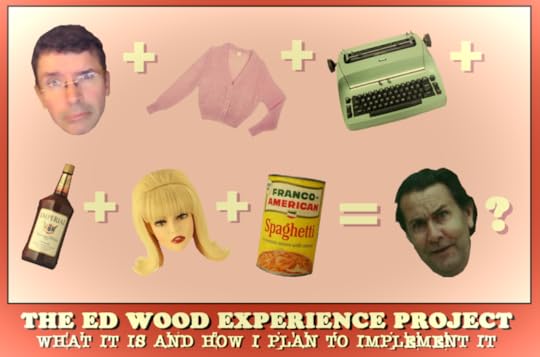 Some Ed Wood math. Are my calculations correct?
Some Ed Wood math. Are my calculations correct?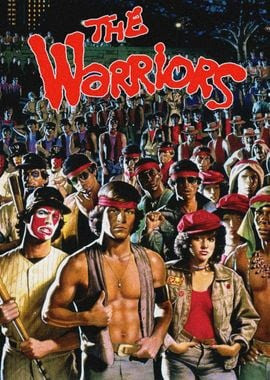 "Come out and play!"A few years ago, I was watching Walter Hill's cult classic The Warriors (1979) when a strange thought occurred to me. As much as I enjoy this highly stylized film about urban decay and gang violence, with its memorable catchphrases ("Can you dig it?") and its outlandishly-costumed hoodlums, I was not watching it in the way it was intended. This film should not be enjoyed from the comfort of a couch in a nice, cozy living room. For maximum impact, you should see it in a sleazy New York grindhouse where you'd think twice about even going into the bathroom for fear of being mugged or worse. Ideally, this theater should also be one where you'd have to take the subway to get home, and your paranoia about that upcoming journey would be on your mind as you watched the film.
"Come out and play!"A few years ago, I was watching Walter Hill's cult classic The Warriors (1979) when a strange thought occurred to me. As much as I enjoy this highly stylized film about urban decay and gang violence, with its memorable catchphrases ("Can you dig it?") and its outlandishly-costumed hoodlums, I was not watching it in the way it was intended. This film should not be enjoyed from the comfort of a couch in a nice, cozy living room. For maximum impact, you should see it in a sleazy New York grindhouse where you'd think twice about even going into the bathroom for fear of being mugged or worse. Ideally, this theater should also be one where you'd have to take the subway to get home, and your paranoia about that upcoming journey would be on your mind as you watched the film.I've had similar thoughts while writing these articles about Edward D. Wood, Jr. Sure, I can watch Eddie's movies and read his many books and articles, and I can theorize about what was happening in Ed's life at the time he created them—for instance, how drunk or sober he was. But what do I really know about this man? After all, I was just three years old when he died. I don't drink. I've never been a Marine, a husband, an actor, a novelist, a pornographer, or a film director.
What's more, I've lived my entire life in the Midwest: first Michigan, then Illinois. I've been to New York City a couple of times but never Eddie's hometown of Poughkeepsie. As for the city where Ed lived and worked for the last three decades of his life, I haven't visited Los Angeles since I went there with my parents on a family vacation many decades ago, and I saw the city mainly from the vantage point of an air-conditioned tour bus. (I did get to meet Cesar Romero, though. On Rodeo Drive, no less!) Cross-dressing has never appealed to me, not even for Halloween. All of my teeth are real, except for one in the front.
If I squint, I can just barely make out a few points of similarity between myself and Ed Wood. We're both Caucasian males born in America during the 20th century. I have written professionally and have dealt with editors, deadlines, and meager paychecks. I share Eddie's interest in classic Hollywood films, especially those of the Universal horror variety. Technically, by the standards of my county, I am living just below the poverty line. But I am frugal with what little money I have, so I've never experienced the bleak, paycheck-to-paycheck desperation that was Eddie's constant reality. Plus, Ed Wood had two expensive, bank-account-draining habits—alcoholism and filmmaking—that aren't a part of my life at all. So my existence is vastly different from Ed's. How could I understand this man without ever wearing an angora sweater or drinking rotgut whiskey?
var infolinks_pid = 3415273; var infolinks_wsid = 0;
Published on July 17, 2024 03:00
July 10, 2024
Ed Wood Wednesdays: John "Bunny" Breckinridge and his Criminal Associates (Guest Author: James Pontolillo)
 This week, James delves deep into the criminal connections of Bunny Breckinridge.
This week, James delves deep into the criminal connections of Bunny Breckinridge.John Cabell "Bunny" Breckinridge (1903-1996) lived the kind of florid, capricious life that is generally only possible through the medium of significant wealth [1] . Bunny was a charming, genteel, and eccentric individual with a dramatic flair for retelling the events of his life… real or imagined. He loved to inform listeners that First Lady Barbara Bush once told him that she could not introduce him to any of her handsome sons because they would surely fall hopelessly in love with him. As Joe Blevins (2023) observed, Bunny was "not just a flamboyantly gay man, but like the kind of over-the-top caricature of a gay man that you might see in a comedy sketch. And at the same time, his careful diction and quasi-regal manner suggest that he is a gentleman of considerable wealth and breeding. He gives off unmistakable 'old money' vibes."
Actor Bill Murray's hilariously coarse interpretation of Bunny in Ed Wood (1994), regardless of its inaccuracy, has become a touchstone for many where the socialite is concerned [2] . The movie's truncated timeline (ending with the March 15, 1957 preview of Plan 9) allowed director Tim Burton to avoid darker aspects of both Bunny's and Ed Wood, Jr's lives. In 1959, Bunny was at the center of a child molestation case that resulted in him being sent to Atascadero State Hospital [3] , one of California's secure psychiatric hospitals for offenders with mental disorders. Overlooked all these years is the window that the case opened onto Bunny's connection with the criminal underbelly of 1950s California. The indiscriminate associations that he pursued as part of his itinerant lifestyle were not without consequence.
var infolinks_pid = 3415273; var infolinks_wsid = 0;
Published on July 10, 2024 03:00
July 9, 2024
Podcast Tuesday: "Amazon Women on the Earth"
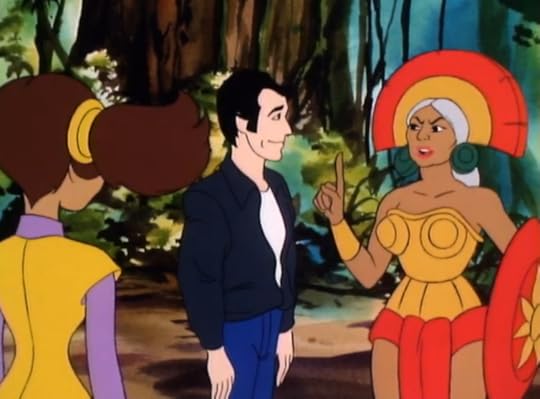 Cupcake (Didi Conn) and Fonzie (Henry Winkler) confer with an Amazonian queen (June Foray).
Cupcake (Didi Conn) and Fonzie (Henry Winkler) confer with an Amazonian queen (June Foray).This week on The Fonz and the Happy Days Gang, Fonzie (Henry Winkler) and his time-traveling pals find themselves stranded in the sweltering Amazon jungle, thousands of miles from their hometown of Milwaukee. And that's not the worst of it! They're captured by a tribe of fierce warrior women (whose leader is voiced by Rocky & Bullwinkle star June Foray) and threatened by a couple of treasure-seeking smugglers (one of whom is voiced by ventriloquist Paul Winchell).
And our heroes have to deal with other typical jungle problems, too, including carnivorous plants, quicksand, and rickety rope bridges. If all this sounds like something out of an Indiana Jones movie, remember that this episode, "It's a Jungle Out There," premiered in January 1981, six months before the release of Raiders of the Lost Ark (1981). So Hanna-Barbera beat George Lucas and Steven Spielberg to the punch.
This is certainly an action-packed story. In fact, there's so much going on in this episode that I was overwhelmed the first time I screened it. It just seemed like 25 minutes of random chaos and noise to me. But I screened it a second time and was able to glean some kind of story here. Were my efforts worth it? Find out by listening to the latest installment of These Days Are Ours: A Happy Days Podcast .
var infolinks_pid = 3415273; var infolinks_wsid = 0;
Published on July 09, 2024 14:05
July 3, 2024
Ed Wood Wednesdays, week 195: Eddie and the Amazing Colossal Episode Guide (1996)
 Ed Wood was one of the filmmakers lampooned in The MST3K Colossal Episode Guide.
Ed Wood was one of the filmmakers lampooned in The MST3K Colossal Episode Guide.God, I loved mall bookstores.
 My idea of a perfect Sunday.Look, I know there are still malls, and many of those malls still have bookstores. But I think it's safe to say that
the heyday of the mall bookstore
is long over, one of many casualties of the internet. There was a time (think: 1990s and early 2000s) when my idea of a perfect Sunday afternoon involved whiling away a few carefree hours at B. Dalton's and Waldenbooks, mostly browsing but purchasing occasionally, too. I'd always make a beeline for one of two departments, Humor and Entertainment, before wandering over to the magazine rack to see if Cinefantastique or Fangoria had something of interest for me.
My idea of a perfect Sunday.Look, I know there are still malls, and many of those malls still have bookstores. But I think it's safe to say that
the heyday of the mall bookstore
is long over, one of many casualties of the internet. There was a time (think: 1990s and early 2000s) when my idea of a perfect Sunday afternoon involved whiling away a few carefree hours at B. Dalton's and Waldenbooks, mostly browsing but purchasing occasionally, too. I'd always make a beeline for one of two departments, Humor and Entertainment, before wandering over to the magazine rack to see if Cinefantastique or Fangoria had something of interest for me.In retrospect, mall bookstores played a fairly significant role in my life. Some of the last real quality time I had with my father was spent at a large shopping center in northeastern Indiana. While visiting my sister, who lives with her family in a small town near Fort Wayne, my dad and I would always find a few hours to sneak off to the local mall and see what it had to offer. Our first stop would always be Barnes & Noble, which sold a wide variety of books and magazines, plus music, movies, and various tchotchkes. I'm not a coffee drinker, but I came to love the smell of the coffee brewing at the in-store café. And I loved the light classical music playing on the overhead speakers, too. To this day, hearing Beethoven's "Rondo a Capriccio" transports me back to those very pleasant times.
I'm convinced there are a great many books that owe their entire existence to mall bookstores, particularly those books with humorous gimmicks or pop culture connections as their main selling points. A perfect example is The Mystery Science Theater 3000 Amazing Colossal Episode Guide (1996) from Bantam Books. It was typical of the TV-based books of the era: detailed descriptions of the MST3K episodes that had aired up to that time, augmented by reminiscences of the actors, writers, and crew members who worked on the show. Though not exactly essential, the ACEG is a fun souvenir for fans of the long-running comedy series, which at the time was just ending its seven-season run on Comedy Central before moving to the Sci-Fi Channel.
When this book came out, I remember eagerly thumbing through its pages a few times at the mall before finally spending $16.95 (a not-inconsiderable amount) on my own copy. Just my luck, the binding proved extremely fragile, forcing me to transfer the pages of the Amazing Colossal Episode Guide to a Trapper Keeper. At the time, I was just becoming a Mystery Science Theater 3000 fan and there were many episodes I had not yet seen. It blew my mind to think that they'd covered both Kitten with a Whip (1964) and Monster a Go-Go (1965), two obscure cult films whose titles I only knew from the writings of John Waters. I realized from reading the ACEG that I had many hours of entertainment ahead of me.
var infolinks_pid = 3415273; var infolinks_wsid = 0;
Published on July 03, 2024 03:00
June 26, 2024
Ed Wood Wednesdays, week 194: 'Jim's Introduction to Gender Identity' (2017)
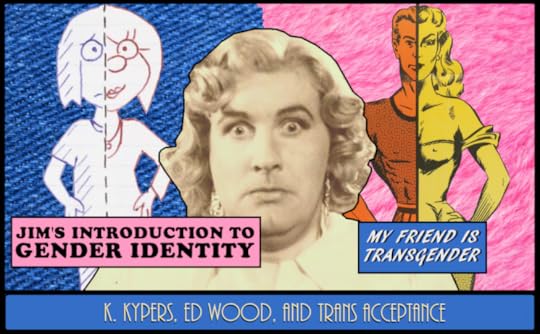 An animated short film from 2017 deals with some of the same issues as Glen or Glenda.
An animated short film from 2017 deals with some of the same issues as Glen or Glenda.As I was rewatching Glen or Glenda (1953) recently, I took note of just how many earnest heart-to-heart conversations this one film contains. Let's see here. Inspector Warren (Lyle Talbot) talks to Dr. Alton (Timothy Farrell). Glen (Ed Wood) talks to his fiancée, Barbara (Dolores Fuller). Glen's sister Sheila (Evelyn Wood) talks to her unnamed female coworker. Glen talks to Barbara some more. Two unseen foundry workers, Jack and Joe, talk to each other. Glen talks to his friend Johnny (Charles Crafts). Glen talks to Barbara a third (!) and fourth (!!) time. Finally, Dr. Alton talks to Glen and Barbara. That's a lot of conversation for a film that's barely feature-length.
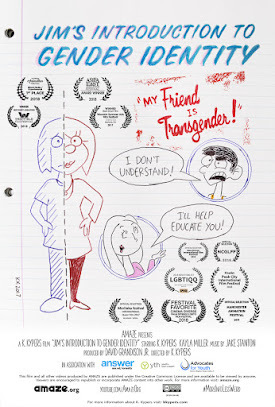 Some Glenda-esque poster art.Glen or Glenda deals with some sensitive and highly controversial topics, including cross-dressing and gender reassignment, and writer-director Edward D. Wood, Jr. obviously felt the best strategy was to have his characters sit down and exchange their thoughts and feelings about these things. In
Cult Movies 3 (1988)
, critic Danny Peary even compares Glenda to old-fashioned soap operas in which women talk through their problems with friends over the kitchen table. It's a nice thought, isn't it? Maybe more of the world's problems could be solved if we'd just stop shouting at each other and started a calm, reasonable dialogue instead.
Some Glenda-esque poster art.Glen or Glenda deals with some sensitive and highly controversial topics, including cross-dressing and gender reassignment, and writer-director Edward D. Wood, Jr. obviously felt the best strategy was to have his characters sit down and exchange their thoughts and feelings about these things. In
Cult Movies 3 (1988)
, critic Danny Peary even compares Glenda to old-fashioned soap operas in which women talk through their problems with friends over the kitchen table. It's a nice thought, isn't it? Maybe more of the world's problems could be solved if we'd just stop shouting at each other and started a calm, reasonable dialogue instead.That's the theory, anyway. Your results may vary.
I thought about all of this as I watched Jim's Introduction to Gender Identity aka My Friend is Transgender (2017), a short film by New York-based animator K. Kypers. A video like this might have flown under my radar, despite garnering over 800K views, but Kypers recently began posting to an Ed Wood group on Facebook that I also frequent. In one thread, Kypers mentioned that the poster art for the short film was directly inspired by the iconic, instantly familiar Glen or Glenda poster. As I watched the film itself, I noticed that it contained numerous references to the Ed Wood canon, making it a prime candidate for coverage in this series.
var infolinks_pid = 3415273; var infolinks_wsid = 0;
Published on June 26, 2024 03:00



